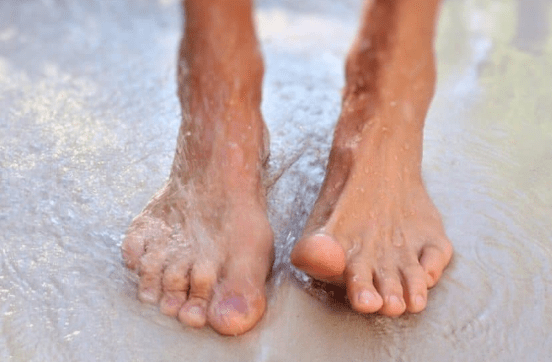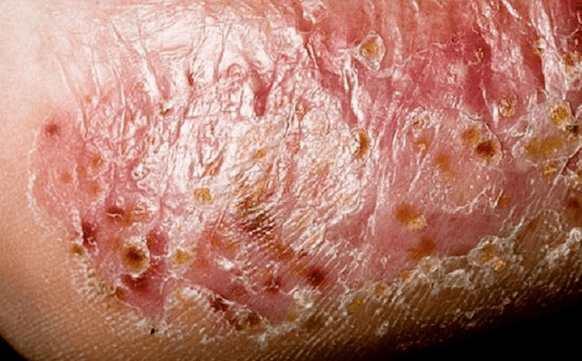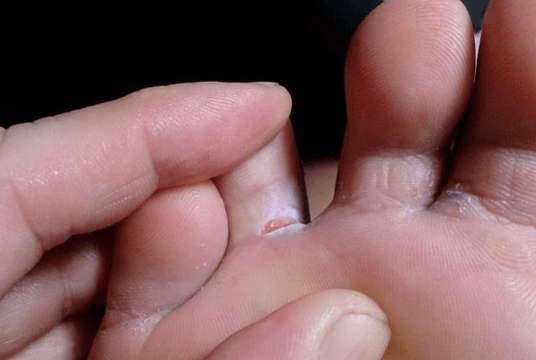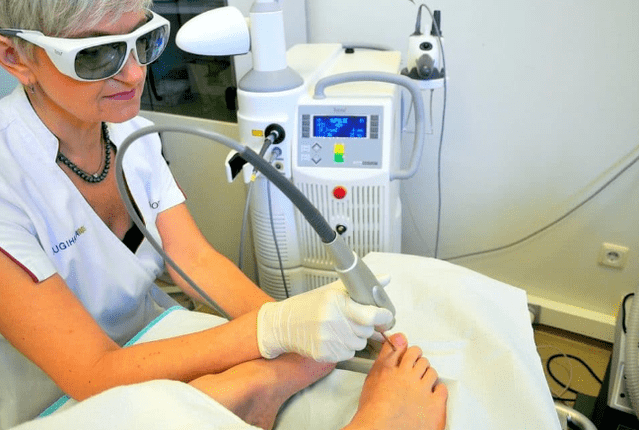This is the general name of infectious diseases that affect a person's leg, legs or arms.In medicine, such pathologies are called mycose - a group of diseases provoked by microscopic fungi.
Onychomycosis is distinguished - nails damage and dermatomycosis - is localized on the skin of the legs.The disease is often an independent disorder, usually in the background of various genesis disorders.What the foot fungus looks like depends on the localization of the pathogen type.

There are many fungal species, but only a few cause abnormal changes in humans.The mycosis of the legs occupies the prevalence of place 2 among all skin diseases.The following groups of fungi can be distinguished that are dangerous to health:
- Anthropophil.Only people provoke pathologies in people, and can become infected with another person.
- Zooanthropophil.They can also cause illness in animals, and the infection comes from animals and other people.
- Candidate.Separate types of yeast that have their own characteristics.
They contain many types of pathologies that have similar symptoms, which includes rubromicosis and epidermophitosis.They are combined according to the general definition of "Mikoza Stop".The symptoms of the fungus are distributed on the legs depending on the type, but often develop in parallel, so this distinction is conditional.The following forms of pathology are distinguished:
- scaly;
- interiginosny;
- Dyshydrotic;
- Onychomycosis, which is distributed: normotrophic, atrophic, hypertrophic.
The scientific name of the disease is onychomycosis.The infection affects the skin, primarily on the lower limbs and nail plates.The yeast and the molds fall on an unprotected surface.
Foot fungus is a fairly common disease that people have surrendered through general use of objects.It is noteworthy that its distribution occurs very quickly, while the development of the disease is concentrated on the areas of the feet.
Reasons
The tested infection occurs with direct contact of the fungus, which is extremely quick to reproduction around the warm and wet surfaces of the skin.It is possible to infect the foot as a result of contact with human skin.
The situation is when the mushroom transmission is used to manicure and pedicure, as well as shoes and towels, is no exception.
Most often, damage to the foot of the leg is among people who have problems with excessive weight and blood legs, and people with deformation of the legs are often subjected to.The infringements in the immune system caused by an unhealthy lifestyle, using stress antibiotics in the treatment of antibiotics and malnutrition also determines the possibility of fungal infection of the foot.
Wet skin, cracks, irritation on the feet, pathogen and conditionally pathogenic fungi cause pathogenic and conditionally.Types of mushrooms are as follows:
- Fungal pathogenic species, when entering the skin, leads to an inflammatory process, a fungal disease occurs;
- Conditionally, pathogenic microorganisms are constantly on the skin and increased activity only occurs with provoking factors.
The source of infection is people with mycosis.Pathogenic vegetation enters healthy skin in people's accumulation sites.Conveniently different types of fungi develop around heat and high humidity.
Place of infection:
- pools;
- bath;
- dressing rooms in sports centers;
- public shower;
- saunas;
- Fitness points.

Important!Never go barefoot in common rooms.For hours in a sports club, in the pool, when you go to the steam bath, take special shoes with you.
Some professions are in danger.This is due to the long stay of the legs in a closed, warm, wet environment.Fungal skin damage often suffers:
- miners;
- Athletes;
- military;
- Hot shop workers.
Listen!Mycoses often develops in those who are required to wear closed shoes, whether they are comfortable with their feet or not.The job descriptions of many professions require boots as a special unit, even in the hot season.It is very difficult to fight mycosis in such circumstances.
Other causes of fungal diseases:
- poor hygiene of the legs;
- skin trauma;
- decreased immunity;
- Fitting shoes without nylon socks;
- Complications of diabetes.
Types and symptoms of foot fungus
There are many types of mushrooms.
The skin's skin is most often affected by the following types:

- The red trichofit is injured in the legs and heels;
- The interdigital trichofite is distributed to the inter -reintegrating zone and, in advanced cases, affects the leg, thumb skin and the epidermis of the small finger;
- Trichophyte mentagrophytes - a kind of fungal infection that develops on the skin of the human body (armpit, inguinal folds);
- Candida fungus - the infection causes candidiasis of the mucous membranes and genitals, but there are also injuries to the feet.
Dermatofit can cause local lesion of the skin.The name of such a disease of epidermophitosis is a very infectious pathology that develops intensively on the human body.
There are three forms of the foot mushroom:
- Interdalz dermatophytosis in acute and chronic form;
- Mochacino-sicut;
- Vesicular, ulcerative.
The general symptoms of the disease are severe itching and burns, skin irritation followed by peeling of particles.These signs are most often seen in the photo on the Internet with the Internet.
Interdalz dermatofitosis
What is this form?The most common, especially between the fingers of the foot 4 and 5.It occurs in the form of cracks: in a wet form, the skin is swollen and peeling and falling in a dry piece.
Often, with interdald dermatologists phithe, other bacterial infections strike at the foot.The advanced form begins.The symptoms are increased, and the discomfort is also - the patient also feels severe pain that should not be rid of.
The initial stage of the interdigital form of the fungus.
If the skin is cracked, the blood can work, causing additional suffering.The psychological factor occurs - some people try to tear off the skin's peeling particles on their own, and this is not recommended as a new infection occurs.The disease worsened.
The usual name for "legged athletes" is about the shape of the fungus on the leg.It is quite difficult to neglect treatment, but it is easiest to recognize.With this pathology, it is affected by nail plates that change the color to black, green, blue or yellow.The transparency is lost, the nails gradually deform, pour and crumble.
The foot at that moment is covered with the scales on the side.The leg will be like a moccasin.
A fairly rare form of the disease compared to Interdaltsevo and mochacino-Sicut.The blisters with muddy liquid manifest on the entire surface of the foot.They ripen and blow up with time.
The photo is shown with the ulcerative shape of the foot fungus
Further signs noticed in patients:
- constant itching and burning;
- peeling, the skin lay;
- fingertips, which are also infected with a fungus that comes in contact with the infected parts of the body;
- swelling of the legs;
- Body temperature sometimes increases significantly.
Causes of the development of the disease
The source of the disease is a person with a foot fungus whose skin particles remained on objects or public use.It can be baths, pools, dressing rooms and showers.Onychomycosis feels good, stable with high humidity and low temperatures.
Most often the causes of the disease:

- AntiSanitaria in beauty salons when pedicure tools do not process or do not do bad;
- Use of others - towels, washing ups, combs;
- Not sufficient hygiene, increased sweating of the legs.
Filling with the hygiene or excessive sweating of the legs leads to the fungus of the foot
But one of the contacts with the microorganismxciter is not enough.There are additional risk factors that exacerbate the situation and enhance and accelerate the development of the disease.
They belong to:
- Injuries of the feet and nails because the disease often turns to the skin in the event of an infection;
- Reducing immunity.As this happens, the microorganisms take revenge and become much more difficult to get rid of them;
- HIV infection;
- Bad habits - alcoholism, smoking, overdose;
- cardiovascular disease, diabetes mellitus;
- Lymphostasis of the lower limbs.
Sections and their manifestations
Legs are defeated with the microorganism of the pathogenic flora in several stages or clinical forms on the skin:
- echoed or initial stage;
- interdigital infection;
- Squamous hyperatic form;
- Dyshidrotic section (wet fungus).
Folk medicines to treat fungus
Folk treatment methods can only be used as complementary agents.As a main method of treating fungus, folk drugs are ineffective, but can improve the therapeutic effects of drugs.
First and foremost, baths are used.It has an antifungal effect and steams the skin, improves the penetration of ointments and solutions into the deep layers of the epidermis.Baths can be done according to the following recipes.
- Add 4 tablespoons of vinegar into the pool with water and steam the leg for 15 minutes.
- Take two tablespoons of salt, soda and iodine solution for 4 liters of water.
- Add boric acid powder to the bath at 10 g / 2 liters of water.
- Dissolve four tablespoons of tar soap in a pool with hot water, add half a glass of soda.
- Add 100 g of soda and a lemon juice to the bath with water.Fresh juice can be replaced with 10 drops of lemon essential oil.
The baths should be done daily during the entire treatment period.We recommend that you use it before applying an antifungal agent.You can also use creams with the foot fungus.The propolis tincture promotes acceleration of healing.This should be mixed equally with the water, then moisten the cotton tampon in the resulting solution and treat the skin of the feet.
To date, there are many recipes for traditional medicine, which is largely lower than some drugs.It is worth noting that the positive result of alternative therapy can only be observed in the early stages of fungal infection.The advanced form of stop mycosis is not exposed to conventional medicine.
Traditional medicine, as well as various drugs, can be useless in the treatment of fungus on the legs.But there are some that have been proven for centuries.
Tea tree essential oil is the best medicine that does not cause a threat to general health.Therefore, it can be safely used in pediatrics.Due to the presence of the antiseptic effect, the development of the pathogenic fungus is blocked.
To prepare the therapeutic ointment, mix the aloe vera gel and tea tree oil in 1: 3.This device is rubbed twice daily to the affected areas.Such manipulations are recommended to be done for three months a day.



























